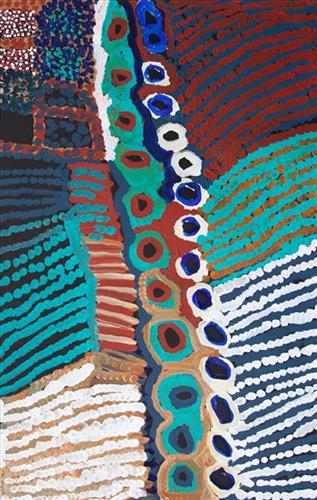111582120109
Untitled
This is Biddy’s Country- her ‘ngurra’ (home Country, camp). People identify with their ngurra in terms of specific rights and responsibilities, and the possession of intimate knowledge of the physical and cultural properties of one’s Country. Painting ngurra, and in so doing sharing the Jukurrpa (Dreaming) stories and physical characteristics of that place, has today become an important means of cultural maintenance.
Biddy’s ngurra encompasses the Country that she and her family walked in the pujiman (traditional, desert-dwelling) era, as well as the stations and communities in which she has resided in later life. Biddy was born in the bush on Anna Plains cattle station, located on the remote Kimberley coast of northern Western Australia, stretching from the shores of Eight Mile Beach to the Great Sandy Desert. She came to work on stations as a ‘grown kid,’ and recalls living in and walking across vast distances over the ‘plains’ (Nyamal Country around Marble Bar) for most of her young life. In the 1970’s she moved to Strelley Station, established by Aboriginal rights activist Don McLeod. In later life Biddy moved to Warralong Community, located between Port Hedland and Marble Bar, where she continues to live today.
Portrayed in this work are features of Biddy’s ngurra, such as the nimarinya (salt) clay pans and the individually named water sources she and her family camped at.




